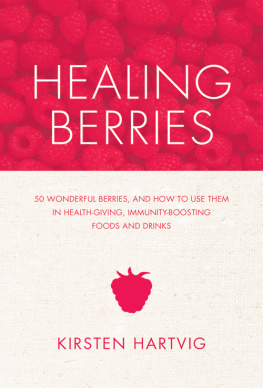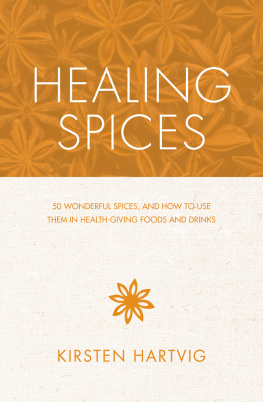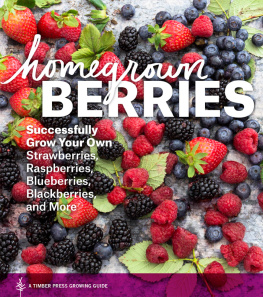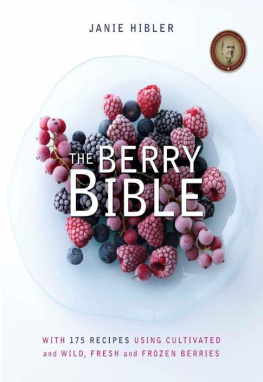HEALING
BERRIES
HEALING
BERRIES
50 WONDERFUL BERRIES, AND HOW TO USE THEM
IN HEALTH-GIVING FOODS AND DRINKS

KIRSTEN HARTVIG

CONTENTS
INTRODUCTION
This book describes 50 different berries: where to find them, how to prepare and use them, and how they can benefit health. It is written to enable culinary explorers, as well as foragers, campers and backpackers, to identify and use berries at home and away, and it includes more than 100 delicious recipes that feature berries. I have written this book in the belief that nature provides for all wildlife and human beings as long as we are not too greedy and do not destroy the plants that grow the berries, nor the habitats that support them. When we remember to share, always leaving something behind as seed for the next generation, we discover that abundance is truly natures way.
Writing Healing Berries has taken more than two years, during which time my family and I have travelled many miles and tested myriad menus featuring berries as the main ingredient. The hunt for more elusive wild berries took us to many remote and beautiful places, and we quickly learnt the importance of good walking boots, long-sleeved shirts, tear-proof long trousers and lightweight materials (because most berries enjoy being in the sun).
Having settled on a working definition of what a berry is (which is surprisingly difficult in botanical terms, see ), we set out to find specimens to use in the recipes: cloudberries in a Scandinavian bog, whortleberries on a remote northern moor, bearberries on a Pyrenean mountainside, jujubes in Londons Chinatown, barberries in a local Lebanese shop, sea-buckthorn on a beach, sloes in a hedge, aronia berries near my daughters school, and others in friends gardens, farmers markets, supermarkets and health food stores.
As I searched and researched the subject, I realized that berries are everywhere. They are probably one of the most common foods on the planet, eaten by almost every species as well as by people of every religious and dietary persuasion. And the most amazing thing is that berries are prepared by plants for the specific purpose of enticing us to eat them. They come in brilliant colours and bite-size, ready-to-eat packages, bursting with health and requiring no (or very little) cooking. They are easy to dry and freeze, keep all year long and provide perfect protection from disease for migrating birds, people and animals. Writing the berry profiles, I was constantly reminded how incredible it is that such humble and easily accessible foods can have such powerful and universal health benefits: in a world full of food and health hyperbole, berry power really does rule!
Working on the recipes, I discovered that many tribes and indigenous peoples have a long tradition of including berries in all kinds of dishes, from main courses to desserts, as well as the more usual jams, syrups and jellies. Taking their example as my inspiration, I have tried to create a modern take on these old ways and I hope that you, too, will enjoy experimenting with the new tastes and textures that berries can offer.
The joy of finding a perfect, peaceful symbiosis with nature is immense and empowering. To know that I have caused no living being to suffer, or be deprived, by eating my own fair share of berries makes me feel more in tune with my inner self. And since, unlike birds and animals, I tend not to fulfil my part of the bargain by delivering seeds wrapped in fertilizer to new environments, I have instead planted
berry bushes in my garden to support their proliferation and provide food for passing wildlife. With urban gardens now sprouting in many parts of the world, I hope that this book will inspire more people to grow berries and to spend more time under open skies, picking this natural source of food and medicine while enjoying the sights, scents and sensations of a simple freedom.
USING THIS BOOK
Botanists use the terms fruit and berry differently from the rest of us. In botanical terms, a berry is a fleshy fruit produced by a plant from a single ovary. Many fruits, such as strawberries, are commonly thought of as berries but do not fit this strict technical definition. On the other hand, bananas, cucumbers, melons and apples are, botanically speaking, berries. So, for practical purposes, it is usual to define berries as small, juicy, edible fruits that are round or oval in shape, sweet to sour in taste, generally brightly coloured and containing seeds or small stones.
In this book, I have decided to include some berries that are normally thought of as vegetables tomatoes, for example, are probably the most popular berries around the world and some that are usually considered as fruits (for example, the kiwi fruit and the persimmon). I have also included some small fruits (cherries, damsons and rose hips) that are not berries in the formal botanical sense, but that grow in typical berry habitats, contain similar phytonutrients and are commonly used as food and medicine in the same ways as true berries. Some true berries are not included because, even though they fulfil the technical definition, they are inedible or poisonous, or too easily mistaken for other poisonous fruits or berries.
As you look through the berry profiles and pictures on pages 17 95, you will notice that berries belong to a small number of botanical families and species that share similar characteristics and habitat preferences. Just because some berries in a family are edible, however, this does not mean that all berries from that family are safe to eat. For example, goji berries from the Solanaceae family are highly nutritious, but the berries of several other plants in the Solanaceae group, including the deadly nightshade and the berries of the potato plant are poisonous (although, of course, the potatoes growing underground are safe to eat).
BERRY FACTS
HISTORY, MYTH AND MAGIC
The word berry is at least a thousand years old, though its origin is uncertain. One suggestion is that it comes from the word berg, which in German means mountain, perhaps referring to berries original, natural environment. Berries are often used as symbols in art and literature, and have multiple cultural, religious and mythological associations. In European folklore, for example, blackberries have been linked with Lucifer and bad omens, and once symbolized sorrow, haste and arrogance. However, they have also been used for protection against malevolent energies and to treat disease. The elderberry was considered mean, and many thought destroying an elder tree would anger the spirit within it causing sorrow and remorse. Yet carrying elderberries about your person was also thought to offer protection from all types of negativity and to bring prosperity.
Raspberries were seen as a symbol of kindness and fragility; strawberries of righteousness and spiritual merit; blueberries of protection; bearberries of psychic powers; and capers of potency, lust and luck. The cherry was for love and divination; and grapes brought fertility, mental powers and prosperity; huckleberry stood for luck, protection and dream magic; and juniper was useful protection during exorcism and against theft. Mulberry and sloes gave protection and strength; Oregon grape attracted money; rowan brought healing, power and success; and cranberries were associated with the abundance of the Earth. And of course, some children are still told that babies come from under a gooseberry bush!










